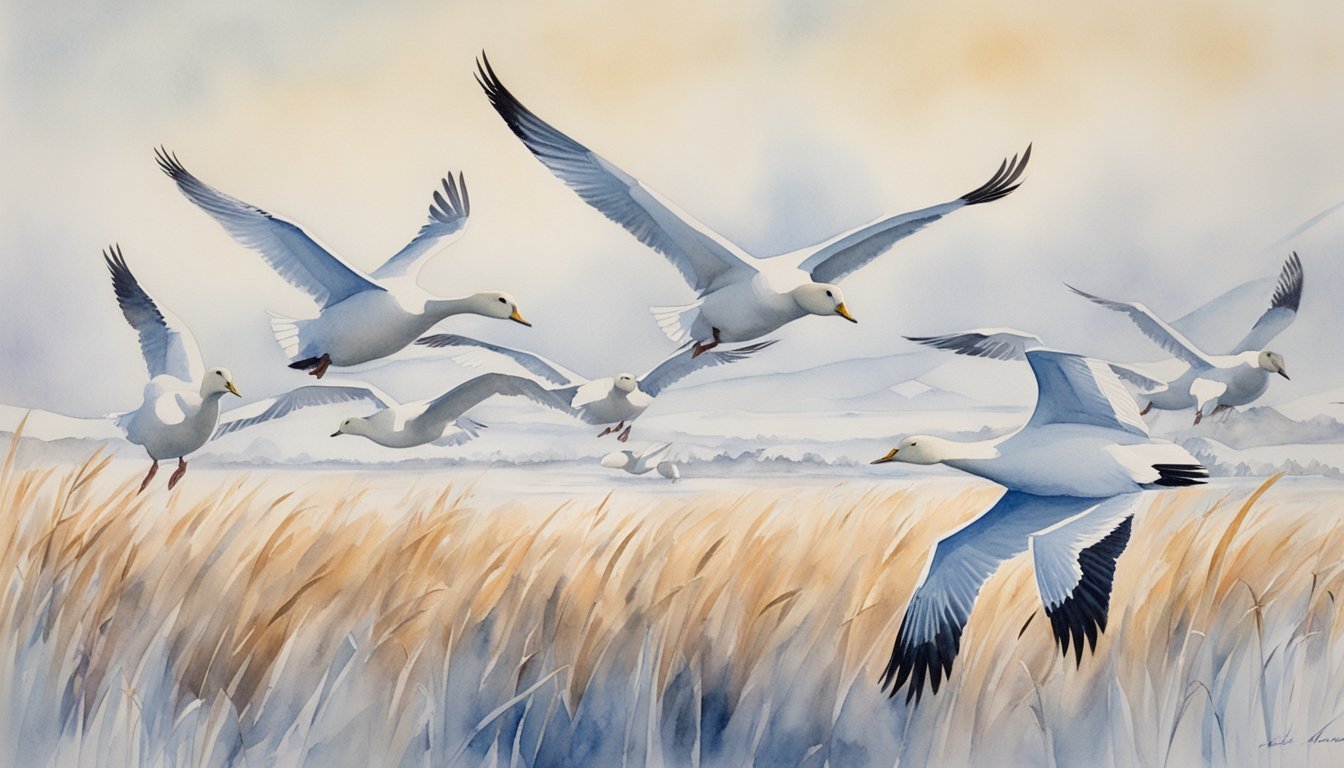Understanding Snow Geese
Snow Geese, known by their scientific name Anser caerulescens, are a species marked by their impressive flocks and bi-colored morphs. These birds play an important role in the ecosystem and have a distinctive presence in their habitats.
Species Overview
Anser caerulescens or the Snow Goose is a resilient species with a notable comeback story, rebounding from low numbers in the early 20th century to now thriving across North America. Their populations are so abundant that they have even become a concern for some arctic and subarctic ecosystems due to their intensive foraging habits.
Physical Description
An adult Snow Goose typically measures between 25 to 31 inches in size and has a wingspan ranging from about 54 to 66 inches. They exhibit two primary color phases: the white morph, which displays predominantly white plumage with black flight feathers, and the blue morph, also known as the ‘Blue Goose,’ characterized by its bluish-gray plumage. The juveniles start with grey feathers before maturing into their adult coloration, and breeding adults are often spotted by their care for eggs and nesting practices.
Habitat and Distribution
Snow Geese breed in the tundra regions of North America, specifically in regions like Canada, Alaska, Greenland, and parts of Siberia. They winter farther south in the United States and along the coasts. During their migrations, vast flocks can be seen in the skies, forming impressive formations that are a spectacle for bird watchers. These geese favor wetlands, marshes, and agricultural fields where they forage for food. Maps of their distribution show a broad presence across numerous flyways.
The current conservation status according to the IUCN is that of least concern, which is a testament to successful bird conservation efforts. Despite this favorable status, ongoing monitoring is critical to ensuring that their populations remain stable and do not negatively impact other species sharing their habitat.
For more specifics on the various aspects of Snow Geese, visit their species profile on All About Birds and information on their identification at All About Birds ID Guide. For an in-depth analysis of their habitat and conservation, consider suchscience.org on Snow Geese for a well-rounded view of these beautiful birds.
Behavior and Ecology

Snow Geese display fascinating migratory patterns and social behaviors, thriving within intricate ecosystems. They demonstrate a unique approach to their life cycle and face various conservation threats in their North American habitats.
Migratory Patterns
Snow Geese embark on long-distance flights along established flyways that span across North America, migrating in large flocks to reach their breeding or wintering grounds. Their migration is a spectacle, often involving thousands of birds moving together in meticulous V-shaped formations that improve aerodynamics and conserve energy. Their journey takes them from wintering grounds in warmer regions to the northern tundra each spring.
Learn more about Snow Goose Migration Patterns
Feeding Habits
As they travel and in their various habitats, Snow Geese feed primarily on a vegetarian diet consisting of roots, grasses, seeds, and leaves. They can often be observed foraging in agricultural fields, where their diet may include leftover grains from fallow cornfields. Their feeding behavior can cover the ground in a snowy blanket, leaving striking visual changes to the landscapes they visit.
Understand Snow Goose Feeding Habits
Reproduction and Lifecycle
Breeding usually occurs on Arctic and subarctic tundra, where Snow Geese form nests to lay their eggs. Featuring a strong pair bond, Snow Geese generally mate for life, returning to the same breeding grounds each year. Goslings are born with a soft, yellowish down and quickly learn to feed and swim under the guidance of both parents.
Study the Snow Goose Life History
Conservation and Threats
Though not currently endangered, Snow Geese populations face threats from hunting and habitat loss. Conservation efforts have been implemented, like regulated hunting seasons and habitat protection measures, to help manage and protect these birds. Predation from species such as the Snowy Owl also affects their populations.

